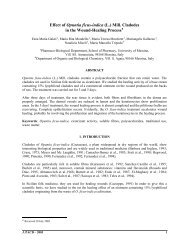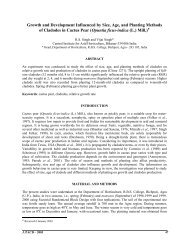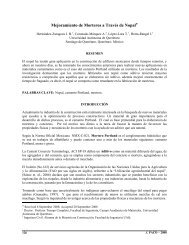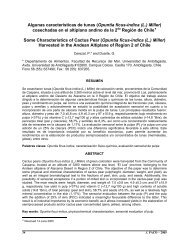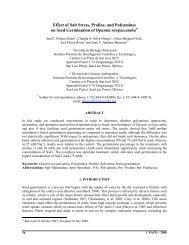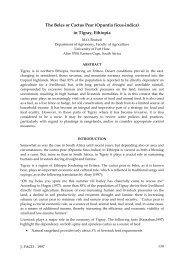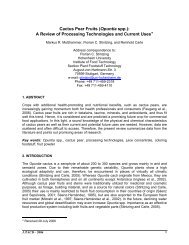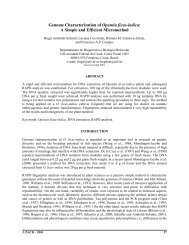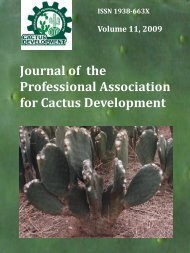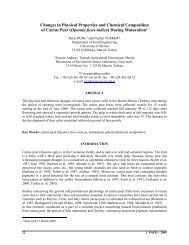Pectins from Opuntia spp.: A Short Review
Pectins from Opuntia spp.: A Short Review
Pectins from Opuntia spp.: A Short Review
You also want an ePaper? Increase the reach of your titles
YUMPU automatically turns print PDFs into web optimized ePapers that Google loves.
Figure 1. Simplified and Schematic Representation of the Architecture of the Cell Wall.Cellulose microfibrils appear crosslinked by hemicellulosic polymers. <strong>Pectins</strong> present in the middlelamella are Ca 2+ crosslinked to each other (McCann and Roberts 1991).Chemical Structure of Isolated <strong>Pectins</strong>Chemically, pectins are a family of complex heteropolysaccharides comprised by a diversity ofcarbohydrate residues. Like most other plant polysaccharides, pectins are polydisperse in composition andmolecular size, that is, they are heterogeneous with respect to both chemical structure and molecularweight. Their composition varies with the source and conditions of extraction, location, and otherenvironmental factors (Chang et al. 1994). The main component common to most pectins is a backbonechain structure of α-(1→4)-linked D-galacturonic acid units interrupted by the insertion of (1→2)-linkedL-rhamnopyranosyl residues in adjacent or alternate positions (Aspinall 1980). The amount of rhamnosein pectins is typically 1% to 4% These linear segments consisting predominantly of galacturonan arecalled homogalacturonans. The degree of polymerization (DP) of uninterrupted galacturonosyl regions inhomogalacturonan segments <strong>from</strong> apple, beet, and citrus lies in the range of 70 to 100 (Thibault et al.1993). Another important feature of galacturonans is the esterification of carboxylic groups ingalacturonic acid residues with methanol and in certain pectins, their hydroxyl groups are also partiallyacetylated. The degree of methylation (DM) is defined as the number of moles of methanol per 100 molesof galacturonic acid. <strong>Pectins</strong> are called high-methoxyl (HM) pectins when the value for DM is 50 orhigher. While when DM is below 50, the pectin is called low-methoxyl (LM) pectin. When less than 10%of the carboxyl groups are methylated, one speaks of pectic acid. The degree of acetylation (DAc) isdefined as the percentage of galacturonosyl residues esterified with one acetyl group. DAc is generallylow in native pectins, ranging between 3% and 15% (Voragen et al. 1995). The botanic origin and theextraction procedure determine the content of galacturonic acid, DM, and DAc in pectins.Other constituent sugars are attached in side chains, the most common being D-galactose, L-arabinose,and D-xylose. D-glucose, D-mannose, L-fucose, and D-glucuronic acid are found less frequently. Themajor sugars, D-galactose and L-arabinose, are present in more complex chains with structures similar tothose of arabinans and arabinogalactans and with chain lengths that can be considerably large.<strong>Pectins</strong> in <strong>Opuntia</strong> <strong>spp</strong>.The occurrence of pectins in various <strong>Opuntia</strong> species <strong>from</strong> Mexico has been documented for almost threedecades (Villarreal et al. 1963). Table 1 shows data <strong>from</strong> such early studies in which the pectin contentsfound in eight species and varieties of <strong>Opuntia</strong> were compared. The yield of soluble pectin in thesesamples was within a wide range of 0.13% to 2.64% in wet basis (1.00% to 23.87% in dry-weight basis).18 J. PACD – 2003



